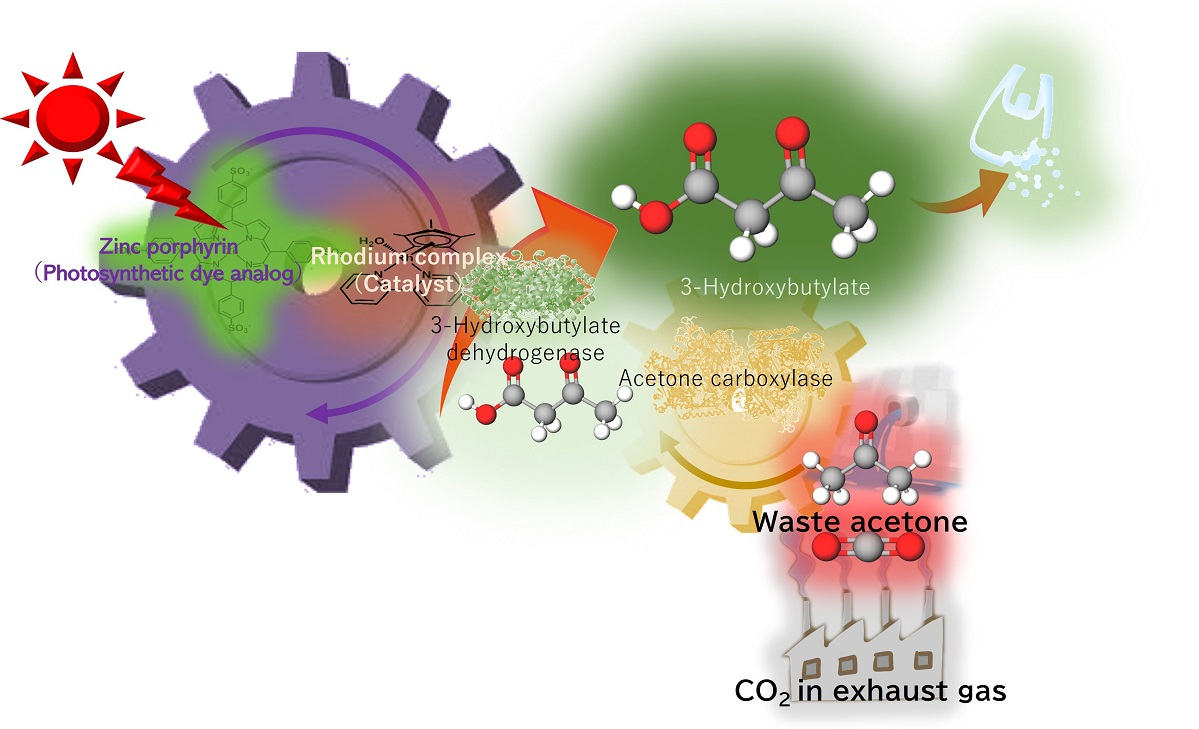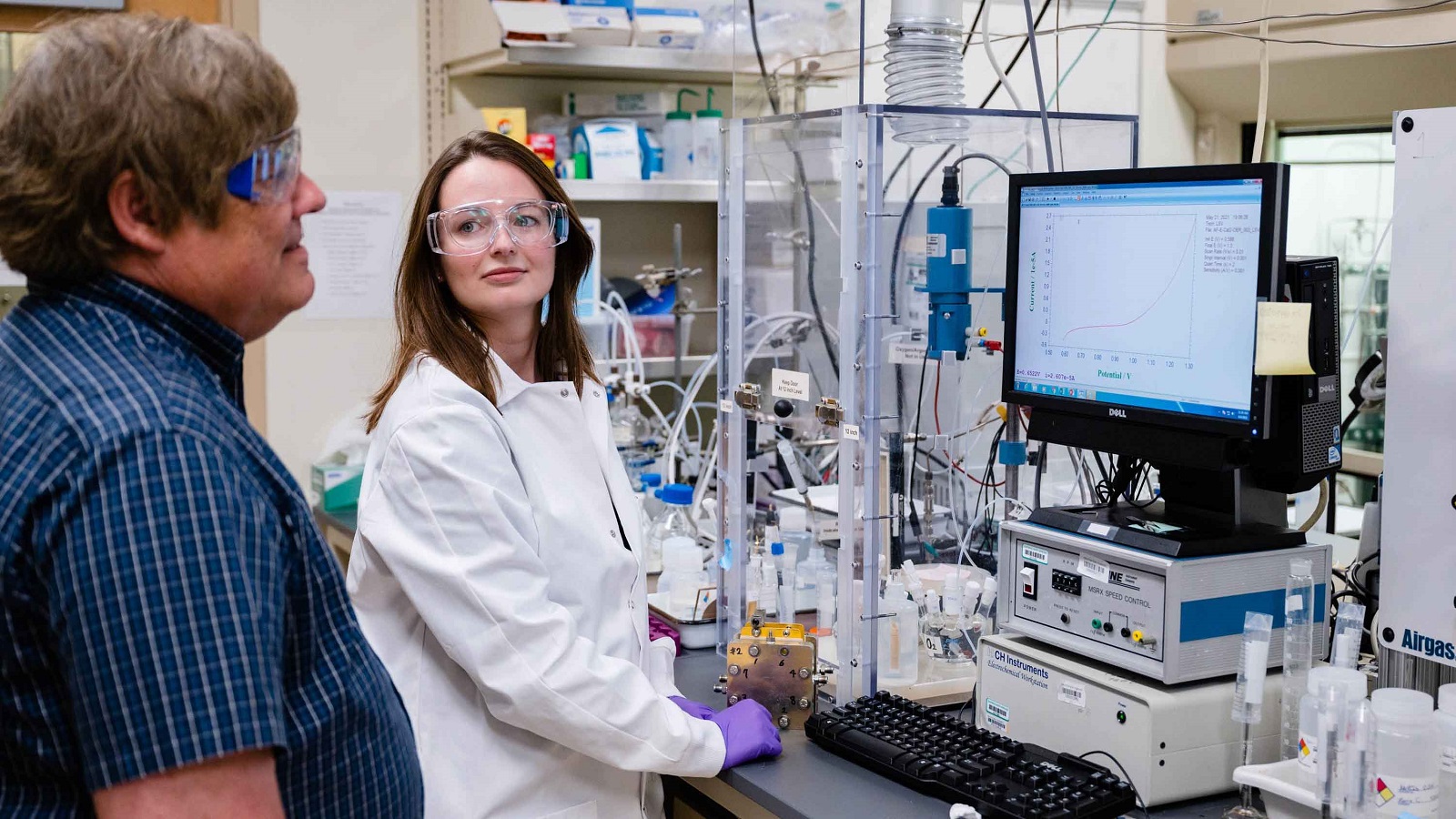Detection of per- and polyfluoroalkyl substances (PFAS) by interrupted energy transfer
Tag: POLYMER CHEMISTRY

Low concentration CO2 can be reused in biodegradable plastic precursor using artificial photosynthesis
Poly-3-hydroxybutyrate—a biodegradable plastic—is a strong water-resistant polyester often used in packaging materials, made from 3-hydroxybutyrate as a precursor.
What can we do about all the plastic waste?
The Institute for the Cooperative Upcycling of Plastics (iCOUP) is helping to address the plastic waste accumulation problem by developing the science needed to turn used plastic into valuable materials.

Entrepreneurship program at Argonne National Laboratory opens applications for startups
Chain Reaction Innovations, the entrepreneurship program at Argonne National Laboratory, is accepting applications for its next fellowship cohort.
Argonne researchers win four 2022 R&D 100 awards
R&D Magazine has recognized four Argonne projects with R&D 100 Awards.
‘Pulling back the curtain’ to reveal a molecular key to The Wizard of Oz
Researchers reporting in ACS Central Science have developed a durable molecular encryption key from sequence-defined polymers that are built and deconstructed in a sequential way. They hid their molecular key in the ink of a letter, which was mailed and then used to decrypt a file.
Degradable coatings for compostable paper food packaging block grease and oil
Many paper cartons and wraps for food have a noncompostable plastic coating. Plastic-free products are available but can transmit grease and oil, creating a mess. Now, scientists have created a degradable coating that can block this seepage. They will present their results at ACS Fall 2021.
NTU Singapore scientists develop tougher, safer bicycle helmets using new plastic material
As cities worldwide expand their networks of cycling paths and more cyclists take to the streets, the chances of cycling accidents and potential collisions increase as well, underscoring the need for proper cycling safety in dense urban areas. According to…
‘Wrapping’ anodes in 3D carbon nanosheets: The next big thing in li-ion battery technology
Study finds that anchoring manganese selenide nanoparticles, an anode material, in 3D carbon nanosheets prevents their expansion in lithium-ion batteries
Smartphone screens effective sensors for soil or water contamination
The touchscreen technology used in billions of smartphones and tablets could also be used as a powerful sensor, without the need for any modifications. Researchers from the University of Cambridge have demonstrated how a typical touchscreen could be used to…
Eco-friendly plastic from cellulose and water
Göttingen University researchers create new kind of environmentally friendly bioplastic with hydroplastic polymers
Press registration opens for ACS Fall 2021 meeting
WASHINGTON, July 15, 2021 — Journalists who register for the fall meeting of the American Chemical Society (ACS) will have access to more than 7,000 presentations on topics including agriculture and food, energy and fuels, health and medicine, space science,…
Wearable sensors with wide-ranging strain sensitivity
Researchers draw inspiration from snake skin in sensor’s structural design
Chemical reactions break free from energy barriers using flyby trajectories
CHAMPAIGN, Ill. — A new study shows that it is possible to use mechanical force to deliberately alter chemical reactions and increase chemical selectivity – a grand challenge of the field. The study led by University of Illinois Urbana-Champaign researcher…
Sweet spot for membrane thickness offers sustainable separations
Super-thin carbon molecular sieve (CMS) membranes may not be best for separating industrially important chemical mixtures. However, ensuring the CMS film thickness is just right could enable more energy-efficient purification of chemical products, KAUST researchers have shown. CMS membranes, as…
Cobalt-containing catalysts used to study super-viscous oil resins at Ashalcha oilfield
A paper saw light in Catalysts.
Bringing chemical production and manufacturing together
Development of a small, flexible and cost-effective acrylonitrile modular reactor could give carbon fiber producers better access to affordable feedstock
Solving the plastic shortage with a new chemical catalyst
In a year that has already battered manufacturing supply chains, yet another shortage is complicating manufacturers’ and consumers’ lives: plastics, and the food packaging, automotive components, clothing, medical and lab equipment and countless other items that rely on them. But…
Hybrid enzyme catalysts synthesized by a de novo approach for expanding biocatalysis
The two major challenges in industrial enzymatic catalysis are the limited number of chemical reaction types that are catalyzed by enzymes and the instability of enzymes under harsh conditions in industrial catalysis. Expanding enzyme catalysis to a larger substrate scope…
Engineered protein inspired by nature may help plastic plague
Cheap to produce and long to degrade, plastic was once a manufacturing miracle. Now, plastic is an environmental plague, clogging landfills and choking waterways. A Japan-based research team has turned back to nature to develop an approach to degrading the…
Soft shell makes hard ceramic less likely to shatter
Rice lab shows complex, 3D-printed schwarzites withstand pressure when coated
Building a better biosensor polymer
A new organic (carbon-based) semiconducting material has been developed that outperforms existing options for building the next generation of biosensors. An international research team led by KAUST is the first to overcome some critical challenges in developing this polymer. Much…
Tiny tweaks to sparkle: Editing light-emitting organic molecules via surface modification
Researchers develop a strategy that allows a single family of polymeric materials to emit light in any of the three primary colors
A new look at color displays
Tunable structural color images by UV-patterned conducting polymer nanofilms on metal surfaces
Microbes in cow stomachs can break down plastic
Bacteria found in the rumen, one of the compartments that make up the cow stomach, can break down plastics, representing an eco-friendly way to reduce litter
Is global plastic pollution nearing an irreversible tipping point?
Common press release: Stockholm University, Norwegian Geotechnical Institute, Alfred Wegener Institute Helmholtz Centre for Polar and Marine Research, Helmholtz Centre for Environmental Research
Editors of MIT Technology Review name Argonne’s Jie Xu as a 2021 Innovator Under 35
The editors of MIT Technology Review have chosen Argonne’s Jie Xu as an Innovator Under 35 for 2021. She is one of only 35 innovators under the age of 35 named to this list. She is being recognized for her research on printable skin-like electronics.
This crystal impurity is sheer perfection
Scientists at Berkeley Lab and UC Berkeley have developed a nanoparticle composite that grows into 3D crystals. The new 3D-grown material could speed up production and eliminate errors in the mass manufacturing of nanoscale photonics for smart buildings or actuators for robotics.
Particles with ‘eyes’ allow a closer look at rotational dynamics
Tokyo, Japan – Colloids–mixtures of particles made from one substance, dispersed in another substance–crop up in numerous areas of everyday life, including cosmetics, food and dyes, and form important systems within our bodies. Understanding the behavior of colloids therefore has…
Can biodegradable polymers live up to the hype?
As consumers and corporations alike become more environmentally conscious, the chemical industry is working to find solutions to the plastic waste crisis. One idea is to use biodegradable polymers known as polyhydroxyalkanoates (PHA) as replacements for traditional plastic packaging and…
New material could remove respiratory droplets from air
‘Every droplet effectively removed from indoor air would eliminate a potential source of transmission’
Pioneering chemistry approach could lead to more robust soft electronics
RESEARCH TRIANGLE PARK, N.C. — A new approach to studying conjugated polymers made it possible for an Army-funded research team to measure, for the first time, the individual molecules’ mechanical and kinetic properties during polymerization reaction. The insights gained could…
UChicago scientists identify properties that allow proteins to strengthen under pressure
A new rubber band stretches, but then snaps back into its original shape and size. Stretched again, it does the same. But what if the rubber band was made of a material that remembered how it had been stretched? Just…
How a bath sponge becomes a bio-based industrial filter
TU Freiberg presents a new composite material
Blavatnik National Awards for Young Scientists announces the finalists of 2021
The Blavatnik Family Foundation and the New York Academy of Sciences today named 31 Finalists for the world’s largest unrestricted prize honoring early-career scientists and engineers
‘Vegan spider silk’ provides sustainable alternative to single-use plastics
Researchers have created a plant-based, sustainable, scalable material that could replace single-use plastics in many consumer products. The researchers, from the University of Cambridge, created a polymer film by mimicking the properties of spider silk, one of the strongest materials…
New way to 3D-print custom medical devices to boost performance and bacterial resistance
Using a new 3D printing process, University of Nottingham researchers have discovered how to tailor-make artificial body parts and other medical devices with built-in functionality that offers better shape and durability, while cutting the risk of bacterial infection at the…
Bacteria-sized robots take on microplastics and win by breaking them down
Small pieces of plastic are everywhere, stretching from urban environments to pristine wilderness. Left to their own devices, it can take hundreds of years for them to degrade completely. Catalysts activated by sunlight could speed up the process, but getting…
German researchers involved in seawater desalination project in the Persian Gulf
Researchers of Mainz University cooperate with partners in the Middle East to provide drinking water to settlements on the Persian Gulf
Engineers apply physics-informed machine learning to solar cell production
Lehigh University researchers use Frontera supercomputer to simulate photovoltaic fabrication, train AI to optimize energy production
Absorbent aerogels show some muscle
Rice lab creates spongelike materials for environmental remediation and more
Online ‘library of properties’ helps to create safer nanomaterials
Researchers have developed a ‘library of properties’ to help identify the environmental impact of nanomaterials faster and more cost effectively. Whilst nanomaterials have benefited a wide range of industries and revolutionised everyday life, there are concerns over potential adverse effects…
Bioinspired acid-catalyzed C2 prenylation of indole derivatives
Terpenoids are omnipresent in almost all living organisms. Prenylated indoles are prominent representatives that usually display potent medicinal properties (e.g. tryprostatin B). Therefore, significant efforts have been devoted to indole prenylation over the past decades. The known protocols often require…
Visualizing cement hydration on a molecular level
Imaging technique could enable new pathways for reducing concrete’s hefty carbon footprint, as well as for 3-D printing of concrete.
Filter membrane renders viruses harmless
Viruses can spread not only via droplets or aerosols like the new coronavirus, but in water, too. In fact, some potentially dangerous pathogens of gastrointestinal diseases are water-borne viruses. To date, such viruses have been removed from water using nanofiltration…
First cells reprogrammed to make synthetic polymers; also making them resistant to viruses
Scientists create cells – with a synthetic genome – and instruct them to make polymers from artificial building blocks for the first time; the new bacteria are also resistant to viral infections
Lighting Hydrogels Via Nanomaterials
Texas A&M associate professor Akhilesh Gaharwar and graduate student Patrick Lee are developing a new class of hydrogels that can leverage light for drug delivery and regenerative medicine treatments.
SwRI works to improve atmospheric water harvesting
Researchers seek to create more efficient, cost-effective method
Peptide nanoparticles marked for in vitro visualization
A joint research by Kazan Federal University and Chinese Academy Sciences has been published in Chemical Engineering Journal.
Nanofibrous filters for PM2.5 filtration
In a paper published in NANO , the author reviewed many kinds of nanofibrous filters including the component, preparation process, and application performances to provide directional guidance for improvement of the air purification field. Poor air quality is worldwide recognized…